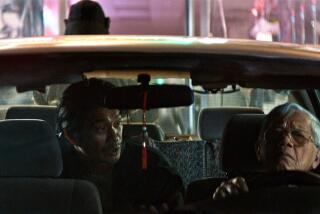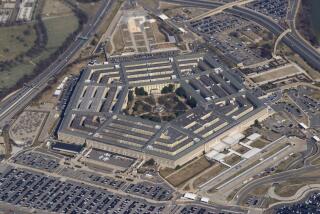Photo Prompts U.S. Query to Vietnam : MIAs: Relatives say they are certain the three men in picture are their loved ones believed lost in Southeast Asia.
A photograph reputed to prove that three American pilots--two from Los Angeles--who vanished and were presumed to have died during the Vietnam War are still alive somewhere in Southeast Asia is the subject of an urgent inquiry, U. S. officials said Tuesday.
The photo showing three middle-age men and a sign that appears to show the date May 25, 1990, has been turned over to Vietnamese diplomatic officials, a spokesman for the State Department said. Similar requests have been made to Laotian and Cambodian government officials, he said.
Vietnamese officials said it was the first time they have received photographic evidence from the United States in an inquiry about military personnel missing in action.
Close relatives have identified the men in the photo as Air Force Col. John Leighton Robertson, originally from Seattle, Air Force Maj. Albro Lynn Lundy of Sherman Oaks and Navy Lt. Larry James Stevens of Canoga Park.
Navy Cmdr. Gregg Hartung, a Pentagon spokesman, said urgent efforts are being made to determine the photo’s validity, including analysis by the “full range of technical means available.”
More than 2,200 Americans who served in the war in Vietnam remain unaccounted for, the vast majority believed dead. But activists involved in the POW-MIA issue contend that anywhere from a few to a few hundred Americans may still be alive--either in captivity, or living freely in Southeast Asia.
The photo and the report that the United States had solicited help from the Vietnamese brought reactions of both hope and skepticism from individuals and groups concerned with POW-MIAs.
Barbara Robertson, who now lives in Santa Ana, told The Times on Tuesday that she is convinced the photo shows her husband, who vanished when his plane was shot down in 1966.
“All the families are positive these are our men,” Robertson added.
“I took one look (at the photo) and said ‘That’s him,’ ” she recalled. “I didn’t have a doubt in the world. None of my children had a doubt. . . . He looked very much like his father. Of course, he had matured.”
Asked how she could be sure, Robertson said that she and her husband had been married for 15 years before he disappeared.
“I went with the man four years in college,” she added. “I gave him four children, six grandchildren. I am still in love with him.
“Is that enough for you?”
At one point as Robertson spoke over the telephone, a television news broadcast flashed the photo.
“Well, that’s Johnny on the left,” Robertson said. “There’s no doubt. None, none, none.”
Her voice broke with emotion. “Whoa. . . . We have kept that private and hidden and to see it just flash on TV, it kind of hurt.”
Robertson said she had been “in limbo” all those years, wondering whether her husband was dead or alive. She acknowledged that the three families had been aware of the photo for weeks, but chose to pursue their questions quietly through political allies and government contacts.
Robertson and representatives of the Lundy and Stevens families plan to hold a press conference in the Los Angeles area today to present “a united front” in hopes of securing answers to the fate of the men.
Robertson, who would be 60, was shot down Sept. 16, 1966, over North Vietnam and listed as missing in action. Lundy, who would be 58, was also shot down in 1966, over Laos, and listed as killed. Stevens, of Canoga Park, who would be 50, was downed on Feb. 14, 1969, over Laos and listed as missing.
The existence of the photo, and the families’ convictions, surfaced publicly during a recent annual convention of the National League of Families of American Prisoners and Missing in Southeast Asia.
The development brought a hopeful reaction from activists seeking a resolution to questions about the missing. There have been incidents in which positive identification of MIAs by loved ones has proved false, activists say. But it is rare that three positive identifications correspond to a single photo.
“The fact that the families ID’d them really gives it a lot of credibility,” said Kelly Murphy, a spokeswoman for the league. “We hope this will finally be a truthful report.”
Questions persist about the source of the photo, Murphy said.
Jack Bailey, an independent POW-MIA researcher, said he received a copy of the same photo last year, as well as a letter supposedly written by Stevens.
Bailey said he hopes the evidence proves valid, but that he had been unable to verify its authenticity. It is difficult to separate truth from fiction, he said, because of the con games and black market that has evolved from the search for POW-MIAs.
“This thing floated around all over Thailand,” Bailey said of the photo. “Everybody and their brother tried to sell this information.”
Retired Navy Capt. Eugene (Red) McDaniel, a former POW and founder of the American Defense Institute, “was entrusted with the photograph by a source of his,” ADI spokesman John Isaf said. The institute was founded to inform officials and the public of the need for a strong defense policy.
McDaniel then made the contacts with relatives of Lundy, Stevens and Robertson, he said. McDaniel decided to release the photo and the men’s names on Tuesday after receiving approval from the relatives, he said.
An official with the Vietnamese mission at the United Nations described the photo as being of poor quality and emphasized that it is not known where it was taken.
“You know there’s always been speculation (that American POW-MIAs are still alive in Southeast Asia), but this is the first time that the U. S. government has sent us a photo,” said the official, who requested anonymity.
“It’s not the first time our government has received live-sighting reports,” he added. “In the process we have investigated many, but it came out they were always wrong.”
The Vietnamese official disputed claims, often voiced by American activists, that his government has engaged in a cover-up concerning MIA-POWs. He said Vietnamese officials will work with the U. S. government’s newly established POW-MIA liaison office in Hanoi in attempting to establish the fates of the three men.
Tuesday’s development coincides with mounting criticism over the U. S. government’s handling of the POW-MIA issues. Last March, Army Col. Millard Peck resigned as head of the Pentagon’s POW-MIA research unit, claiming that “live-sighting reports” and other evidence are routinely discredited by disbelieving officials.
Times staff writer Lanie Jones in Orange County contributed to this story.
More to Read
Sign up for Essential California
The most important California stories and recommendations in your inbox every morning.
You may occasionally receive promotional content from the Los Angeles Times.










